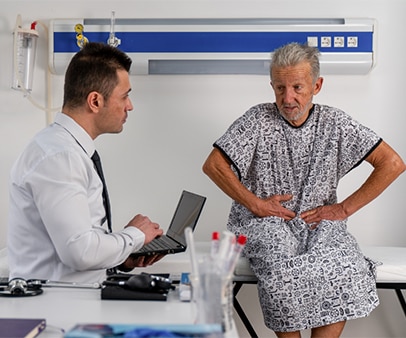What Is a Hernia?
Hernias are a very common medical condition that occurs when an organ or fatty tissue bulges through a weak spot in the muscle wall or fascia (the thin lining of connective tissue surrounding most parts of the body) containing it.¹
Each year roughly 5 million Americans experience a hernia, and over one million hernia repair surgeries are performed.¹ ² Although hernias are very common, they are more prevalent in men than women. Approximately 1 in 4 men (25%) and 1 in 50 women (2%) will require surgery for hernia repair during their lifetime.¹ While hernias can oftentimes be painless, it is important to know the signs and symptoms of a hernia to help prevent further complications.
Basic Hernia Symptoms3,4,5
Although hernias can be asymptomatic, symptoms commonly seen in people with hernias include:
- Appearance of a bulge while coughing, lifting items, going to the bathroom, or performing other strenuous activities
- Discomfort or pain at the site of a bulge
- Heartburn
- Constipation
- Weakness
- Feeling of being full
Risk Factors for a Hernia6
Most hernias are caused by a combination of pressure and an opening or weakness of muscle or connective tissue. While muscle weakness may be present at birth, an increase in abdominal pressure or certain risk factors may make you more prone to developing hernias later in life. Examples include:
- Age
- Gender (Male)
- Being born prematurely or having a low birth weight
- Damage from an injury or surgery
- Overexertion during exercise or lifting heavy objects
- Persistent, chronic coughing
- Pregnancy (or multiple pregnancies)
- Diarrhea or constipation
- Being overweight, obese, and/or having poor nutrition
- Smoking
- Personal family history/genetic conditions
Is This Hernia Pain or Something Else?
There are several conditions that present with similar pain to a hernia. These include, but are not limited to those discussed below. Talk to your doctor if you’re experiencing any pain.
- Groin Strain: A hernia can often be mistaken for a groin strain as both conditions can cause a burning, tugging sensation around the groin and weakness in the area for an extended period of time. If you detect a lump on one side of your groin that is most noticeable while walking or standing, you may be suffering from a hernia. However, it is possible to have a groin hernia even without a bulge forming. To be sure, consult your doctor.⁷
- Ovarian Conditions: Women are less likely to suffer hernias compared to men. And, because hernias in women are often small and internal, they’re oftentimes misdiagnosed as ovarian cysts or other ovarian conditions. If a woman is continually suffering from abdominal or groin pain and other explanations have been ruled out, a hernia may be the culprit. Consult your doctor to be sure.⁷
- Appendicitis: Hernias may cause some discomfort or dull pain, but if you feel a strong, intense pain around the abdominal region, especially if it comes on suddenly, that may be a sign of appendicitis. If the intense abdominal pain continues or worsens over 12 to 24 hours and is causing nausea and vomiting, consult a medical professional immediately.⁷
- Diastasis Recti: Diastasis recti is a common condition in pregnant and postpartum women that usually develops in the third trimester. It occurs when the “six pack ab muscles” (rectus abdominis muscles) separate due to stretching from pregnancy, causing a bulge at the midline from increased abdominal pressure. Most people don’t notice diastasis recti until the postpartum period and/or it usually resolves itself within eight weeks of delivery. It can be repaired with special exercises designed to help close the separation, or in more severe cases, may require surgery. Be sure to talk to your doctor about your concerns.⁸
Common Hernia Locations
If you’re unsure what your symptoms are indicating, here are some common locations hernias can occur in:
- In your lower chest through your diaphragm (Hiatal)
- In your groin through your lower abdominal wall (Inguinal, Femoral)
- Along the front midline of your abdomen near your belly button (Umbilical)
- Near a former abdominal surgical incision (Incisional)
The Common Types of Hernias Explained⁹
- Inguinal Hernia (groin): Accounting for 75% of all hernias,⁹ inguinal hernias mostly affect men or people assigned male at birth (AMAB). They occur when part of your bowel protrudes into the passageway that runs down your inner thigh (the inguinal canal).
- Femoral Hernia (thigh): A less-common type of groin hernia, femoral hernias occur when fatty tissue pokes through the area that runs underneath the inguinal canal (the femoral canal).
- Umbilical Hernia (belly button): A mostly congenital condition (present from birth), an umbilical hernia occurs when part of your intestine pokes through an opening in your abdominal wall near your belly button.
- Incisional Hernia (near the site of a scar from a previous surgery): A common side effect of abdominal surgery, an incisional hernia occurs when tissue protrudes through a former incision in your abdominal wall that weakened over time.
- Hiatal Hernia (diaphragm): A common type of hernia, hiatal hernias occur when the opening in your diaphragm (the area where your esophagus passes through) widens and the top of your stomach pushes up through the opening into your chest.
Other Less Common Types of Hernias
- Congenital Diaphragmatic Hernia: A serious birth defect where the diaphragm doesn’t completely during fetal development, congenital diaphragmatic hernias can cause abdominal organs to slip up into the chest cavity while the organs are still growing. This in turn may crowd the lungs and lead to complications.
- Perineal Hernia: A relatively rare type of hernia, perineal hernias occur when organs or tissue push through an opening or weakness in the pelvic floor into your abdominal cavity.
- Strangulated and Incarcerated Hernias: Strangulated or incarcerated hernias occur when the tissue bulging through the abdomen cannot be pushed back in, which can result in cutting off of blood flow. People who have strangulated or incarcerated hernias may experience the following symptoms:¹¹
- A sudden onset of pain that intensifies quickly
- Nausea
- Involuntary vomiting
- Bloody stools
- Tenderness at the site of the bulge/hernia
- Fever
- Fatigue
Strangulated or incarcerated hernias can be a medical emergency and typically require immediate medical attention. If you are experiencing any of the above symptoms, contact your doctor immediately.
How Is a Hernia Diagnosed?
A hernia is often diagnosed by clinical examination. Hernias typically appear as small lumps and look more pronounced when you cough or do strenuous exercise, such as lifting something heavy. To diagnose a hernia, your doctor will feel for a lump and may ask you to stand from a seated position. He or she may also ask you to cough to make the hernia bulge more prominent.
Your doctor may ask you to undergo an ultrasound or a CT scan to enable a more informed diagnosis.
Hernia Pain: Know When To Go to a Doctor¹²
Any hernia pain is worth a visit to your healthcare provider. It’s important to have a healthcare provider diagnose hernia pain, since many other conditions can be mistaken for a hernia. If your hernia changes color, goes numb, or causes symptoms like fever, nausea and vomiting, seek medical attention right away.
Hernia Treatment Options: Non-Surgical Treatment
Hernias will not heal on their own—surgery is required to repair a hernia. However, if your hernia is small, asymptomatic, and/or only bulges only occasionally, your healthcare provider may recommend taking a “watchful waiting” approach. During this period, you may be advised to closely observe the area for possible symptoms that could indicate a medical emergency. It is likely that your doctor may also observe and measure your hernia to ensure it doesn’t grow or become painful. Ultimately, the decision about your treatment should be made with your doctor based on your specific situation.
Hernia Treatment Options: Surgical Treatment¹³
Surgery is required in order to fully repair a hernia as they will not go away on their own. Hernias also tend to worsen over time which is why providers often recommend repairing them.¹⁰ The appropriate type of surgery for you may depend on the size, severity, and location of your hernia. Discuss with your doctor which option is right for you. There are three primary surgical options for hernia repair: open, laparoscopic, and robotic.
Open Surgery: As the traditional surgical method, an open surgical procedure involves making an incision over the area of the hernia. The hernia bulge is returned to its correct position and a mesh is often placed to help strengthen and support the weakened area before closing up the incision.
Laparoscopic Surgery: A surgeon typically uses several small, key-hole sized incisions during laparoscopic surgery. Instruments, such as a camera, are then inserted through the incisions to perform the operation.
Robotic Surgery: Similar to laparoscopic surgery, robotic surgery uses several smaller incisions. The surgeon performs the operation from a console located in the operating room.
Hernia Mesh Treatment
Most hernia repair surgeries are performed using a mesh. Hernia mesh is used to reinforce the weak spot in the abdominal wall where the hernia was located. Placing mesh over the hernia location provides support and creates a barrier that helps to prevent tissue from pushing through it. Most mesh is attached to the body using stitches, staples/tacks, or glue.
Types of Hernia Mesh¹²
Synthetic Mesh: Synthetic mesh is a permanent implant often made from synthetic plastic (e.g., polypropylene, polyester, or ePTFE). Synthetic meshes remain in your body to help provide long term reinforcement to the repair.
Biorabsorbable Mesh: Bioabsorbable mesh is an implant made of natural biomaterials. These meshes are designed to be absorbed by your body to help protect the repair
- Biologic Grafts: A biologic graft is an implant derived from animal or human tissue. Biologic grafts dissolve completely over time to help support the repair as your body heals.
Preoperative Recommendations
Always follow your doctor or hospital's pre-surgical instructions for what to do and expect after surgery. You may be required to:
- Arrange for someone to collect you from the hospital and bring you home (you will not be able to drive after the procedure for some time).
- Get plenty of rest and avoid lifting anything heavy for at least two weeks.
- If you have to cough, sneeze, or move, apply mild pressure to the site beforehand for support.
- Ask your doctor when you can shower after you get home (you may need to wait 48 hours after your surgery).
- Schedule a follow-up visit with your doctor within two weeks of your surgery date—this will allow your doctor to confirm that your hernia is healing and identify any possible complications of surgery, like an infection.
Postoperative Recovery
Each patient will have a different postoperative recovery and activity level. In general, after surgery, patients typically experience pain or discomfort for some time. Some may feel tired and have less energy than usual. Recovery varies from person to person, but strenuous activity should be avoided for 4–6 weeks.¹² Ask your doctor what you may experience during your recovery and be sure to follow the wound care instructions exactly as prescribed by your doctor.
Should you have any questions or concerns regarding your recovery, do not hesitate to contact your doctor.
The guidance provided in this article follows general rules that should be discussed with your doctor. This article is for informational and educational purposes only. It does not substitute for medical advice. If in doubt, always consult your doctor.
Related Articles
Join the HerniaInfo.com community! Get notified about our latest articles and updates on all things hernia as they become available.
References
- https://www.fda.gov/medical-devices/implants-and-prosthetics/hernia-surgical-mesh-implants
- https://www.trihealth.com/blogs/health-tips/what-to-know-about-hernias-and-hernia-repair
- https://www.medscape.com/answers/189563-45214/what-are-the-sex-related-demographics-for-abdominal-inguinal-hernias
- https://www.stamfordhealth.org/healthflash-blog/surgery/hernia-types-risk-factors/
- https://www.scnv.com/blog/8-silent-signs-you-have-a-hernia
- https://www.healthline.com/health/hernia#causes
- https://surgerygroupla.com/is-my-pain-a-hernia-3-commonly-mistaken-conditions-for-a-hernia/
- https://my.clevelandclinic.org/health/diseases/22346-diastasis-recti#:~:text=Diastasis%20recti%20(diastasis%20rectus%20abdominis,%22six%2Dpack%20abs.%22
- https://my.clevelandclinic.org/health/diseases/15757-hernia
- Pluta RM, Burke AE, Golub RM. Abdominal Hernia. JAMA. 2011;305(20):2130.
- Sorenson, Hemmingsen, Kirkerby et al. Smoking is a Risk Factor for Incisional Hernia. JAMA. February 1, 2005.
- FitzGerald JF, Kumar AS. Biologic versus Synthetic Mesh Reinforcement: What are the Pros and Cons? Clin Colon Rectal Surg. 2014;27(4):140-148. doi:10.1055/s-0034-1394155 https://www.ncbi.nlm.nih.gov/pmc/articles/PMC4477030/
- https://www.hopkinsmedicine.org/health/conditions-and-diseases/hernias/ventral-abdominal-hernia?text=A ventral
This site is not intended as a substitute for professional medical care. Only your physician can diagnose and appropriately treat your symptoms. BD does not recommend the use of any particular physician or team of physicians. Please consult your healthcare provider for advice regarding who should be part of your hernia repair team.
BD-95835


